Welcome to the wild world of words, where your titles aren’t just doorways to your articles but neon signs that make travelers stop and stare. Yes, we know nailing the art of SEO title optimization can be tricky, but it doesn’t have to be.
Titles and Headlines: Is There a Difference in SEO?
Understanding the distinction between titles and headlines is crucial when optimizing your travel blog for search engines. Both play important roles in SEO but serve slightly different purposes.
Title Tags are HTML elements that accurately and concisely describe a webpage’s content. These appear in the browser tab and SERPs and are one of the most critical elements for SEO.
Effective title tags are tailored to include key search terms that align with your target audience’s content and search intent.
Headlines, mainly H1 tags, are often visible at the top of your content and serve as the main heading of a page. In many cases, the H1 doubles as the title tag, especially in content management systems, like WordPress, that automatically generate this structure. The key with H1s is incorporating primary keywords and capturing the reader’s interest.
Now, what about subheadings? Subheadings (H2, H3, etc.) organize content into easier-to-read and navigate sections. H2s might cover subtopics under your central theme, while H3s could delve into specifics under each H2 section.
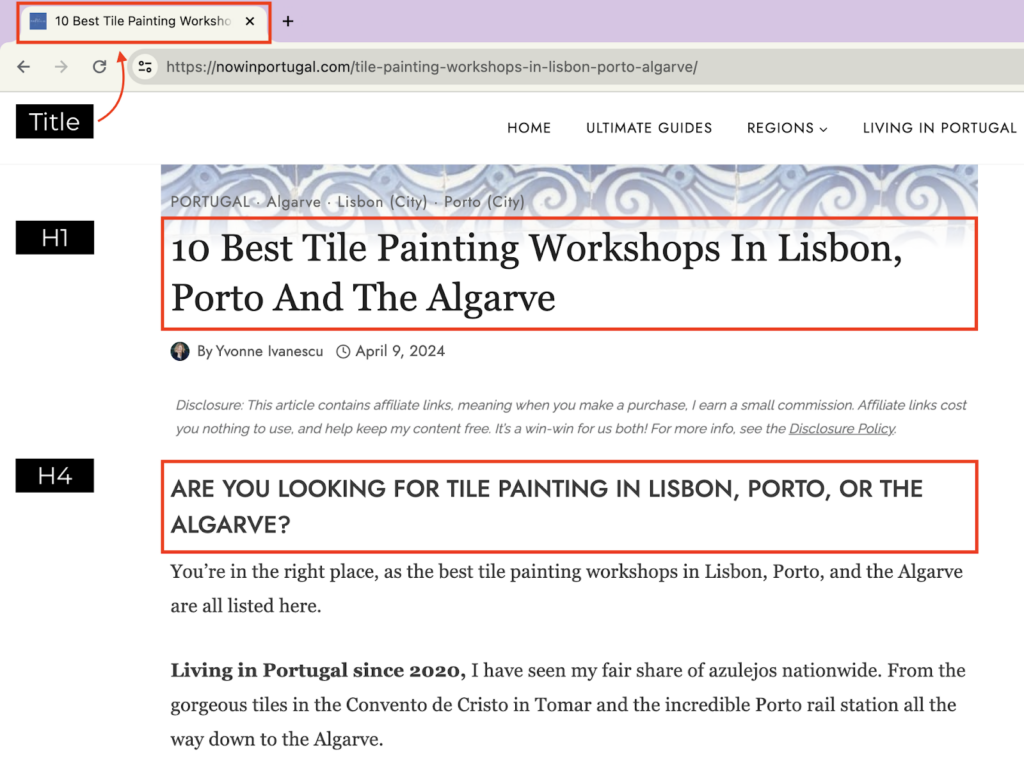
From an SEO perspective, your SEO title tag should align with the H1 heading but be optimized for search engines. The H1 should be engaging enough to keep the reader on the page. Subheadings like H2s and H3s play supportive roles in improving readability and structural SEO. This helps search engines understand your content, positively influencing your rankings.
Titles and Headlines in WordPress
In the context of WordPress, the placement of the SEO title tag and the H1 heading can typically be found as follows:
TITLE TAG
- In WordPress, the title tag is usually generated automatically when you enter the title of your post in the “Title” field while editing a post or a page. This title appears in the search engine results, browser tabs, and when shared on social media.
- You can customize the title tag using SEO plugins like Yoast SEO or Rank Math. These plugins allow you to adjust the SEO title tag independently of the post’s main title, optimizing it for better search engine visibility without changing the headline your readers see.
H1 HEADING
- The H1 heading is typically the title you enter in the “Title” field in the WordPress editor. It also appears as the main headline at the top of your post or page. When you view your post, this is the prominent title at the beginning of your content.
- WordPress themes are designed to automatically use the title of your post or page as the H1 heading. This is crucial for both readers and SEO, signaling the content’s main topic.
When you write and publish a post in WordPress, the title you input generally serves as the title tag (for SEO and browsers) and the H1 heading (the main headline your readers see). SEO plugins can be beneficial if you need more control over your SEO settings, including customizing the title tag without altering the H1.
Why It’s Important to Keep SEO in Headline and Title Creation
Creating SEO-friendly titles and headlines is essential for any travel blogger looking to boost their site’s visibility and, ultimately, their income. Here’s why this practice is so important:
- Boosts Organic Traffic: Incorporating relevant keywords into your SEO titles and headlines makes it easier for search engines to understand and rank your content. This leads to better visibility in search results, attracting more visitors naturally without paid advertising.
- Increases Reader Engagement: SEO-friendly headlines that clearly state the content’s topic can capture the interest of potential readers. A compelling headline makes visitors likelier to click through and read your post.
- Enhances Income Opportunities: More traffic often translates into more revenue opportunities, mainly if you use affiliate marketing. The more people visit your blog, the higher the chance they’ll click on affiliate links and make purchases, earning you a commission.
- Improves Content Credibility: Well-optimized headlines help establish your content as relevant and authoritative. When search engines consistently rank your articles highly, it signals to readers that your content is trustworthy.
In short, smart SEO in your titles and headlines helps increase your visibility and plays a big role in growing your audience and boosting your earnings as a travel blogger.
7 Best Practices on How to Write SEO Titles and Headlines
Creating an SEO title and headline is an art that combines creativity with strategic planning. For travel bloggers, mastering this skill can significantly boost your content’s reach and effectiveness.
Here are seven best practices to help you craft the perfect SEO title and headline that resonate with both search engines and readers:
1. Include Relevant Keyword
Focus on the main keyword that aligns with the content you’re targeting. Place this keyword early in your SEO title and title tag to clarify the purpose of your content, making it easier for search engines like Google to understand and prioritize it.
To find the most effective keywords, you can utilize tools suited to different needs and budgets:
- Free Tools: Google Keyword Planner offers basic insights into search volumes and competition, ideal for beginners.
- Mid-Tier Tools: KeySearch provides more detailed analysis at an affordable cost.
- High-Tier Tools: SEMrush and Ahrefs are comprehensive platforms for in-depth keyword research and competitive analysis—perfect for advanced users.
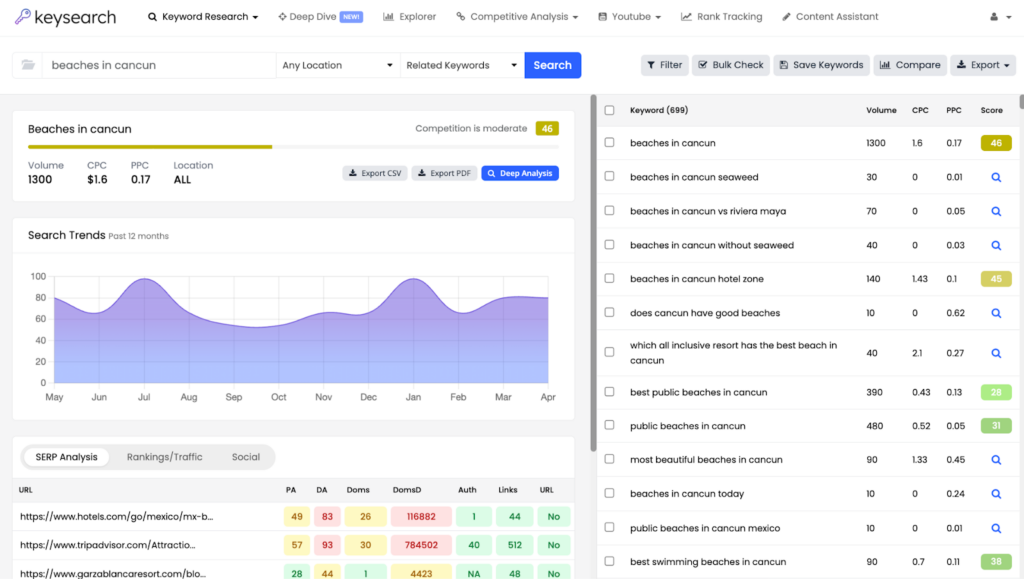
These tools help refine your keyword strategy, ensuring you target terms that attract relevant traffic and match your audience’s search intent.
2. Adhere to User Intent
Speaking about search intent, understanding why and what your audience is searching for is crucial. Align your SEO title with user intent—be it informational, navigational, or transactional. This alignment ensures that the content meets the needs of the audience, increasing engagement and satisfaction.
For example, consider two different users with distinct search intents for Paris:
- Informational Intent: A user looking for details about Paris is likely searching with the intent to learn and explore. They would be more interested in clicking on a title like “Ultimate Guide to Paris: Everything You Need to Know.” This title promises a broad overview, appealing to their desire for information.
- Transactional Intent: on the other hand, a user ready to book accommodations in Paris has transactional intent. They are in the decision-making phase, looking to take action. A title like “10 Best Boutique Hotels in the Heart of Paris” targets this intent by focusing on specific options and recommendations.
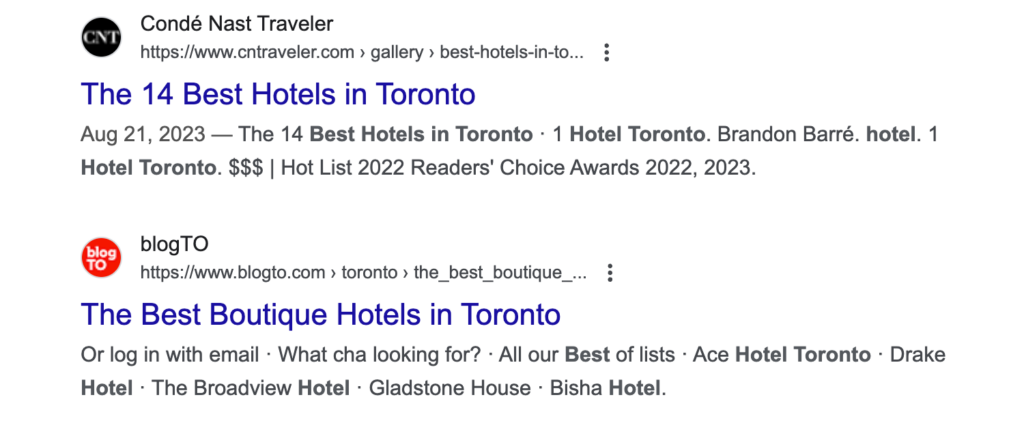
By tailoring your SEO title to match these intents, you effectively draw in readers who are most likely to engage with your content and take desired actions, thereby increasing the overall effectiveness of your SEO strategy.
3. Keep It Concise and Focused
People shouldn’t have to guess what your blog article is about. They should be able to read your SEO title and get the gist. So what is your article about? What should people expect if they click on it? A focused title helps communicate the content’s subject to the audience.
An ideal length for a title tag is about 50-60 characters. Keeping your titles concise ensures they don’t get cut off in search results, making them more likely to be read in full.
Our tip? When using a WordPress SEO plugin like Rank Math or Yoast SEO, look at the preview snippet and see how your title looks on desktop and mobile. This allows you to see if your title is getting cut off. Remember that a lot of people are reading your blog for mobile.


4. Utilize Years and Timely References
Adding the current year or timely references can enhance the relevance of your titles. For instance, “Best Travel Destinations for Summer 2024” instantly communicates that the information is updated and tailored for the upcoming period.
But why does this matter?
- Search engines like Google prioritize current and updated content because it is more likely relevant to the searcher’s needs. Including the current year signals to users and search engines that the content is fresh and contains the latest information.
- Users often prefer content explicitly labeled as recent, especially in fast-changing fields like travel, technology, and trends.
- Users frequently include the year in their search queries when looking for recommendations or guides to ensure they find the most current information. By matching this search behavior in your SEO title, you improve your content’s chances of appearing in relevant searches.
- Competitive Edge: In a crowded content landscape, having the most current year in your title can give you a competitive edge. Promising the most up-to-date advice or insights helps your article stand out among older posts, even if the core content is similar.

This allows you to align with search engine algorithms that favor fresh content while meeting user expectations for relevance and accuracy, increasing engagement and trust in your content.’
5. Use Numbers and Lists
Incorporating numbers into your SEO page title can make them more attractive and clickable. Titles like “10 Hidden Beaches in Thailand” or “5 Budget-Friendly European Cities” clearly outline the content’s scope, making it more appealing to users searching for specific, easy-to-digest information.
6. Don’t Keyword Stuff
Keyword stuffing—overloading your SEO page titles and SEO headlines with too many keywords—can harm your SEO efforts more than it helps. While it’s important to include relevant keywords to optimize your content for search engines, overdoing it can lead to several issues:
- Reduced Readability: Titles and headlines crammed with keywords often don’t make sense to the reader. This can turn potential visitors away because the title seems spammy or unclear, reducing the overall user experience.
- Penalties from Search Engines: Search engines like Google have sophisticated algorithms to detect keyword stuffing. If your content is flagged for stuffing, it could be demoted in search rankings. This means less post visibility, directly affecting your site’s traffic and credibility.
- Decreased Engagement: A title that reads unnaturally isn’t just a turn-off for readers. It also suggests that the content might be of lower quality. Visitors are less likely to engage with content that doesn’t appear to be written for humans first.
Use your primary keyword naturally in the SEO titles, placing it near the beginning to emphasize its importance. Ensure the SEO title is engaging and informative, accurately reflecting the content. This approach helps maintain a good balance between optimizing for search engines and providing a pleasant reading experience for your audience.
7. Get Some Help
Plugins like Headline Analyzer on WordPress are invaluable tools for optimizing your SEO titles and headlines. These plugins provide feedback and suggest improvements, such as adjusting your title length or keyword usage.
The best way to do this is to combine an SEO plugin with a title plugin, like Headline Analyzer. The SEO plugin will tell you if you use your focus keyword in the SEO title, while the Headline Analyzer will provide feedback on your SEO page title.
CoSchedule’s Headline Analyzer also allows you to simultaneously examine the Headline Score and the SEO score, providing suggestions on improving your score.
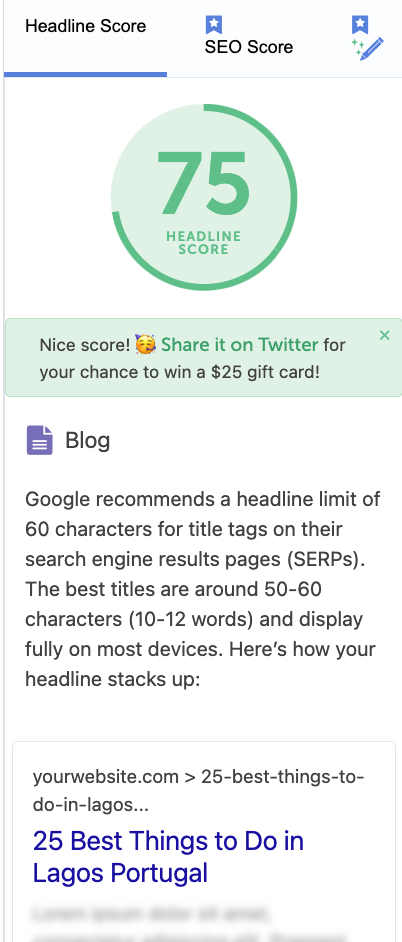
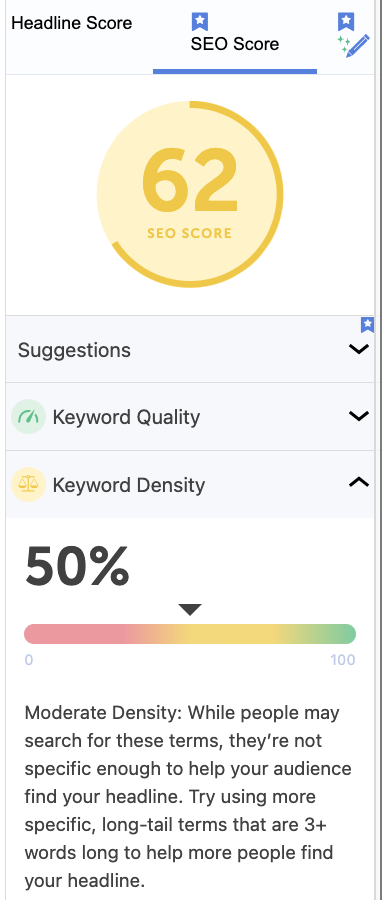
7 Examples and Templates of SEO-Optimized Titles and Headlines
Creating SEO-optimized titles and headlines is essential for any travel blogger aiming to increase visibility and engagement. The right SEO page title can boost your search engine rankings and attract and retain readers’ interest.
Below are practical templates and examples based on SEO best practices. These are designed to be adaptable, ensuring your travel content is discoverable and appealing to your audience.
Before we start, it is important to remember that when creating a title, you must include a mix of different types of words that readers often look for. Your word balance should include:
- Common words
- Uncommon words like best, beautiful, awesome, actually, good, beautiful
- Emotional words like absolutely, valuable, incredible
- Power words like best, actionable, definitive, free, missing out
On top of that, positive or negative SEO page titles tend to get more engagement than neutral ones.
Now that we got that out of the way, ready for some SEO title examples and templates of some good titles?
- Number + Adjective + Keyword + Promise
- Template: “[Number] Best [Adjective] Places to Visit in [Location] [Year]”
- Example: “5 Stunning Beaches to Explore in Thailand 2024”
- How to + Action + Keyword + Benefit
- Template: “How to Experience [Location] Like a Local: [Benefit]”
- Example: “How to Experience Paris Like a Local: Insider Tips for an Authentic Visit”
- Ultimate Guide to + Keyword + Quantified Benefit
- Template: “The Ultimate Guide to [Activity/Location]: Everything You Need to Know for [Outcome]”
- Example: “The Ultimate Guide to Backpacking Europe: Tips for a Budget-Friendly Journey”
- Question + Keyword + Curiosity
- Template: “Why Should You Visit [Location] in [Season/Year]?”
- Example: “Why Should You Visit Japan During Cherry Blossom Season?”
- Avoid + Negative Outcome + With + Keyword + Solution
- Template: “Avoid Tourist Traps in [Location] with These Hidden Gems”
- Example: “Avoid Tourist Traps in Venice with These Local-Approved Spots”
- Secrets of + Keyword
- Template: “Secrets of [Location]: Discovering the Untold”
- Example: “Secrets of the Amalfi Coast: Discovering the Untold”
- Keyword + Guide + Year
- Template: “[Location] Travel Guide [Year]: Top Tips and Attractions”
- Example: “New York Travel Guide 2024: Top Tips and Attractions”
Obviously, there are so many other types of templates and ideas that you can create, so we recommend always testing and seeing which SEO page title best suits your blog. The key is to combine keywords with engaging language and timely references to make the titles as appealing and relevant as possible to both readers and search algorithms.
Final Thoughts: Best Practices for SEO Ranked Headlines & Titles
Mastering the art of title optimization is not just a task but a continuous process that can significantly drive your travel blog’s visibility and engagement. It’s essential to set a clear goal for what you wish to achieve with each title—be it more clicks, higher rankings, or better engagement rates.
Remember, the power of a compelling title extends beyond just catching the eye of your audience; it’s about making your content memorable and easy to find.
Remember the importance of reviewing your strategies over days and weeks to see what works best for your audience. This isn’t just about sticking to a formula. It’s about evolving and adapting your approach as search trends and audience preferences change.
As you continue on this journey, let each title be a step towards achieving your larger content goals, making each word count towards the success of your travel blog.




